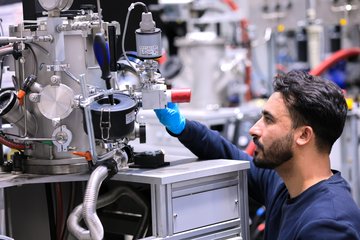All genres
261.
Journal Article
Designing shape-memory Heusler alloys from first-principles. Applied Physics Letters 99, pp. 191904-1 - 191904-3 (2011)
262.
Journal Article
First-principles study on the interaction of H interstitials with grain boundaries in alpha- and gamma-Fe. Physical Review B 84 (14), pp. 144121-1 - 144121-13 (2011)
263.
Journal Article
Methodological challenges in combining quantum-mechanical and continuum approaches for materials science applications. European Physics Journal Plus 126, pp. 101-1 - 101-22 (2011)
264.
Journal Article
Ab initio based determination of thermodynamic properties of cementite including vibronic, magnetic and electronic excitations. Physical Review B 84 (12), 125101 (2011)
265.
Journal Article
A density functional theory based estimation of the anharmonic contributions to the free energy of a polypeptide helix. Journal of Chemical Physics 135 (8), pp. 084122-1 - 084122-7 (2011)
266.
Journal Article
Growth process, characterization, and modeling of electronic properties of coupled InAsSbP nanostructures. Journal of Applied Physics 110 (4), pp. 043708-1 - 043708-6 (2011)
267.
Journal Article
Construction and performance of fully numerical optimum atomic basis sets. Physical Review B 84 (8), 085101, pp. 1 - 11 (2011)
268.
Journal Article
Theoretical modeling of growth processes, extended defects, and electronic properties of III-nitride semiconductor nanostructures. Physica Status Solidi B 248 (8), pp. 1837 - 1852 (2011)
269.
Journal Article
Formation energies of point defects at finite temperatures. Physica Status Solidi B 248 (6), pp. 1295 - 1308 (2011)
270.
Journal Article
The influence of additions of Al and Si on the lattice stability of fcc and hcp Fe–Mn random alloys. Journal of Physics: Condensed Matter 23 (24), 246003 (2011)
271.
Journal Article
Ab initio study of electron paramagnetic resonance hyperfine structure of the silicon dangling bond: Role of the local environment. Physical Review B 83 (14), 144110, pp. 1 - 8 (2011)
272.
Journal Article
Role of spin quantization in determining the thermodynamic properties of magnetic transition metals. Physical Review B 83 (16), 165114 (2011)
273.
Journal Article
The object-oriented DFT program library S/PHI/nX. Computer Physics Communications 182 (3), pp. 543 - 554 (2011)
274.
Journal Article
Hydrogen-enhanced plasticity at dilute bulk H concentrations: The role of H-H interactions and the formation of local hydrides. Acta Materialia 59, pp. 2969 - 2980 (2011)
275.
Journal Article
In-situ Scanning Tunneling Microscopy Study of selective dissolution of Au3Cu and Cu3Au(001). SI, pp. 1694 - 1700 (2011)
276.
Journal Article
First-principles investigation of the effect of carbon on the stacking fault energy of Fe–C alloys. Acta Materialia 59, pp. 3041 - 3048 (2011)
277.
Journal Article
Determining the elasticity of materials employing quantum mechanical approaches: From the electronic ground state to the limits of materials stability. Steel Research International 82 (2), pp. 86 - 100 (2011)
278.
Journal Article
Electronic structure of 1/6 <20 2¯3> partial dislocations in wurtzite GaN. Journal of Applied Physics 109, pp. 083511-1 - 083511-6 (2011)
279.
Journal Article
Robustness and optimal use of design principles of arthropod exoskeletons studied by ab initio-based multiscale simulations. Journal of the Mechanical Behavior of Biomedical Materials 4, pp. 129 - 145 (2011)
280.
Journal Article
In situ scanning tunneling microscopy study of selective dissolution of Au3Cu and Cu3Au (001). Electrochimica Acta 56 (4), pp. 1694 - 1700 (2011)











